MKG721 Food Marketing Report: Semester 2, ATMC University
VerifiedAdded on 2022/10/12
|12
|642
|258
Report
AI Summary
This report delves into the multifaceted realm of food marketing, examining the strategies employed to connect food producers with consumers. It defines food marketing as the application of various techniques to enhance the value of food products and influence consumer purchasing decisions. The report explores two prominent trends: direct marketing communication, which leverages personalized approaches like emails and loyalty programs to build brand reputation and customer loyalty; and social media marketing, which utilizes platforms like Facebook and Instagram to reach a global audience cost-effectively. For each trend, the report outlines the channels of communication, the opportunities, challenges, and potential threats associated with their implementation, including the impact of globalization and the importance of brand awareness. The report concludes with an example of Facebook page for Chick-fil-A.
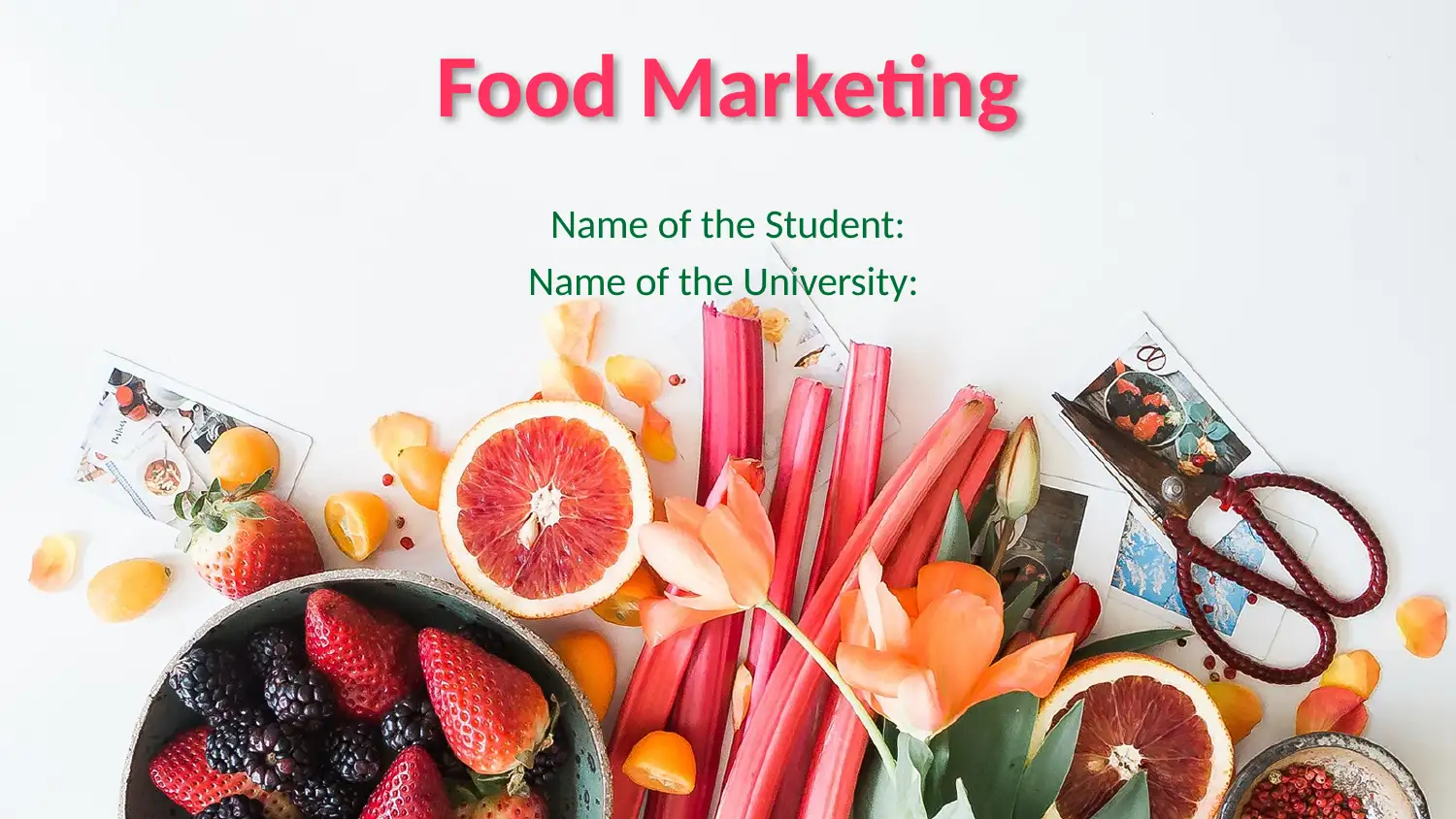
Food Marketing
Name of the Student:
Name of the University:
Name of the Student:
Name of the University:
Paraphrase This Document
Need a fresh take? Get an instant paraphrase of this document with our AI Paraphraser
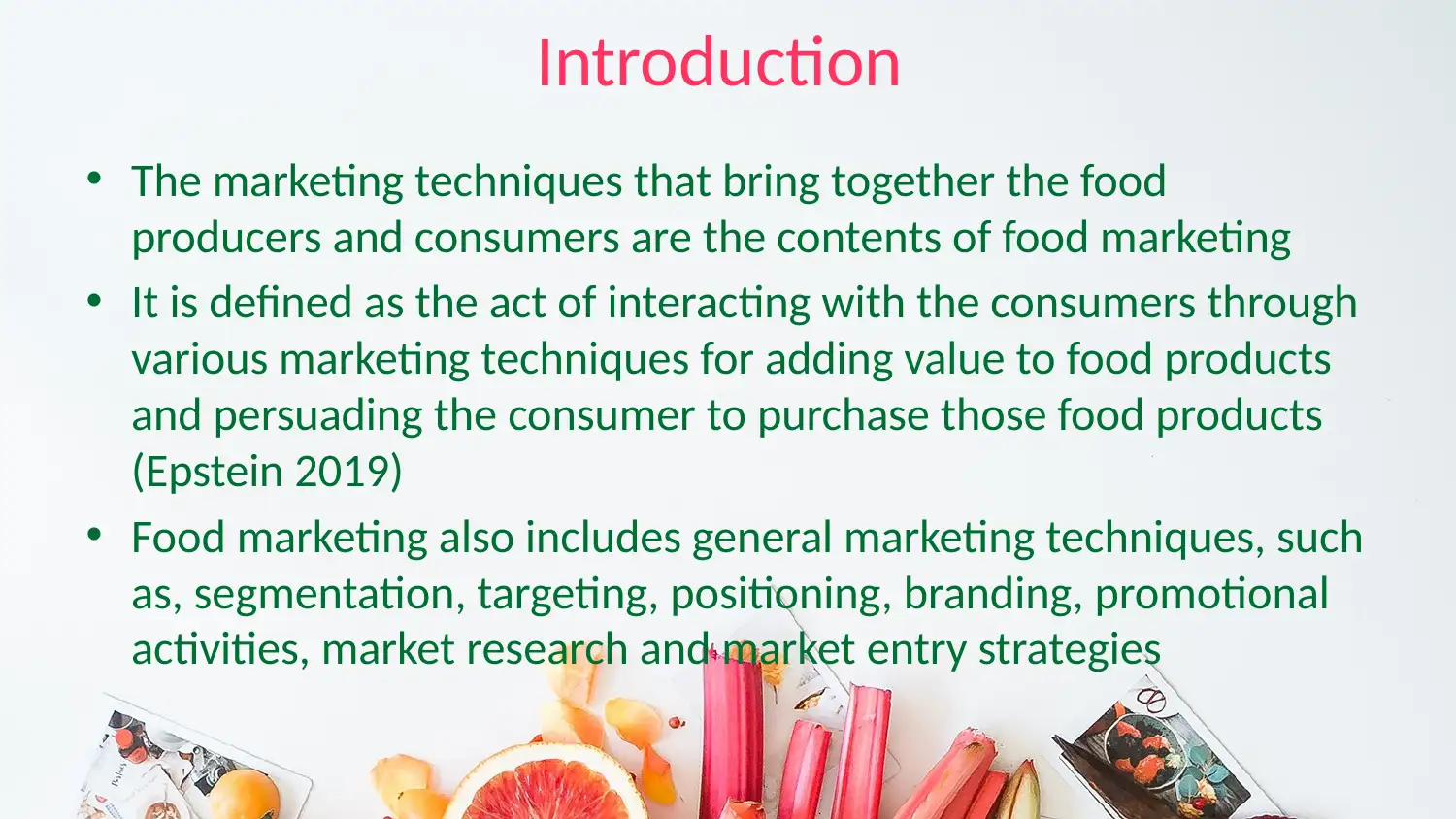
Introduction
• The marketing techniques that bring together the food
producers and consumers are the contents of food marketing
• It is defined as the act of interacting with the consumers through
various marketing techniques for adding value to food products
and persuading the consumer to purchase those food products
(Epstein 2019)
• Food marketing also includes general marketing techniques, such
as, segmentation, targeting, positioning, branding, promotional
activities, market research and market entry strategies
• The marketing techniques that bring together the food
producers and consumers are the contents of food marketing
• It is defined as the act of interacting with the consumers through
various marketing techniques for adding value to food products
and persuading the consumer to purchase those food products
(Epstein 2019)
• Food marketing also includes general marketing techniques, such
as, segmentation, targeting, positioning, branding, promotional
activities, market research and market entry strategies
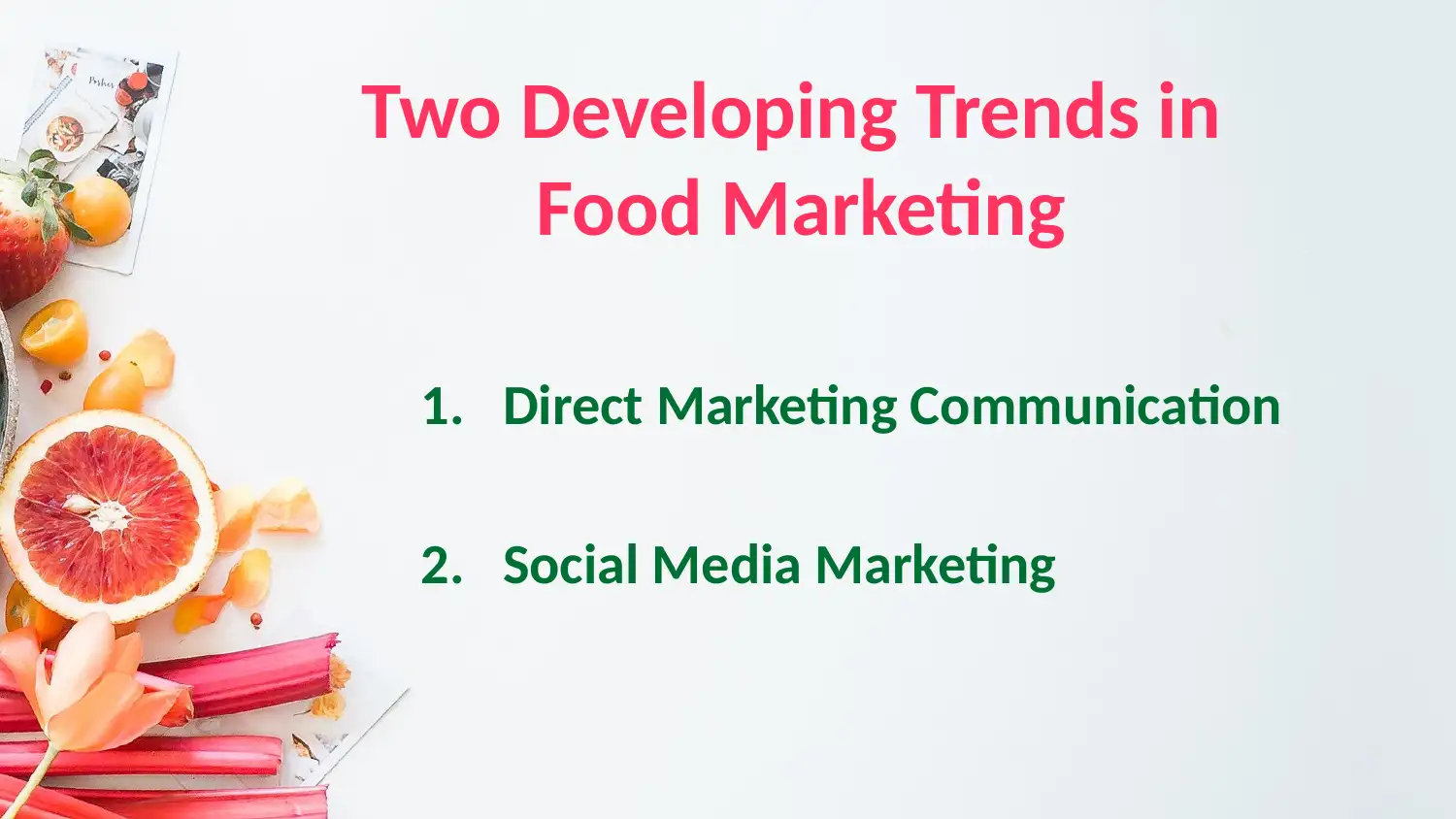
Two Developing Trends in
Food Marketing
1. Direct Marketing Communication
2. Social Media Marketing
Food Marketing
1. Direct Marketing Communication
2. Social Media Marketing
⊘ This is a preview!⊘
Do you want full access?
Subscribe today to unlock all pages.

Trusted by 1+ million students worldwide
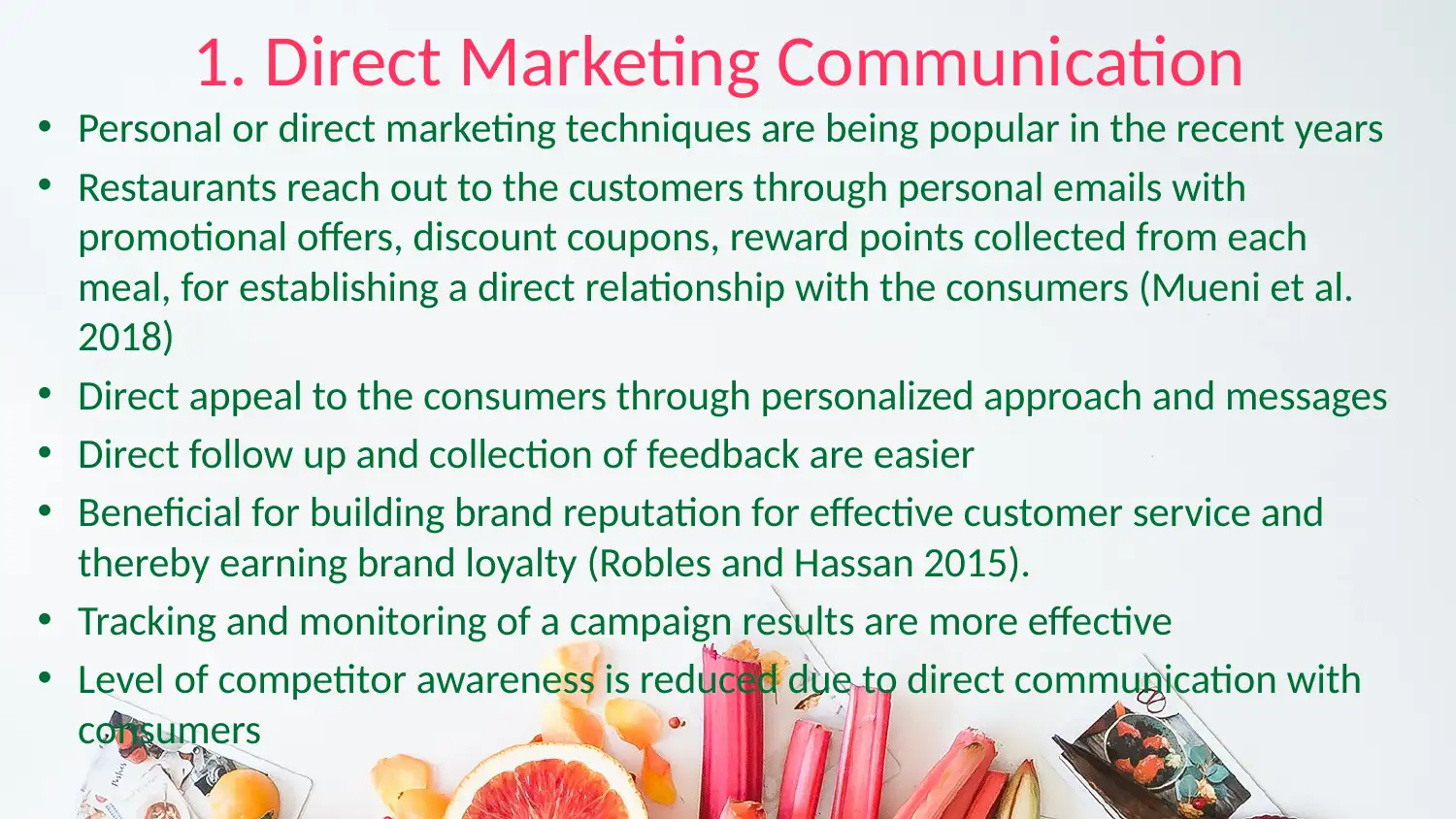
1. Direct Marketing Communication
• Personal or direct marketing techniques are being popular in the recent years
• Restaurants reach out to the customers through personal emails with
promotional offers, discount coupons, reward points collected from each
meal, for establishing a direct relationship with the consumers (Mueni et al.
2018)
• Direct appeal to the consumers through personalized approach and messages
• Direct follow up and collection of feedback are easier
• Beneficial for building brand reputation for effective customer service and
thereby earning brand loyalty (Robles and Hassan 2015).
• Tracking and monitoring of a campaign results are more effective
• Level of competitor awareness is reduced due to direct communication with
consumers
• Personal or direct marketing techniques are being popular in the recent years
• Restaurants reach out to the customers through personal emails with
promotional offers, discount coupons, reward points collected from each
meal, for establishing a direct relationship with the consumers (Mueni et al.
2018)
• Direct appeal to the consumers through personalized approach and messages
• Direct follow up and collection of feedback are easier
• Beneficial for building brand reputation for effective customer service and
thereby earning brand loyalty (Robles and Hassan 2015).
• Tracking and monitoring of a campaign results are more effective
• Level of competitor awareness is reduced due to direct communication with
consumers
Paraphrase This Document
Need a fresh take? Get an instant paraphrase of this document with our AI Paraphraser
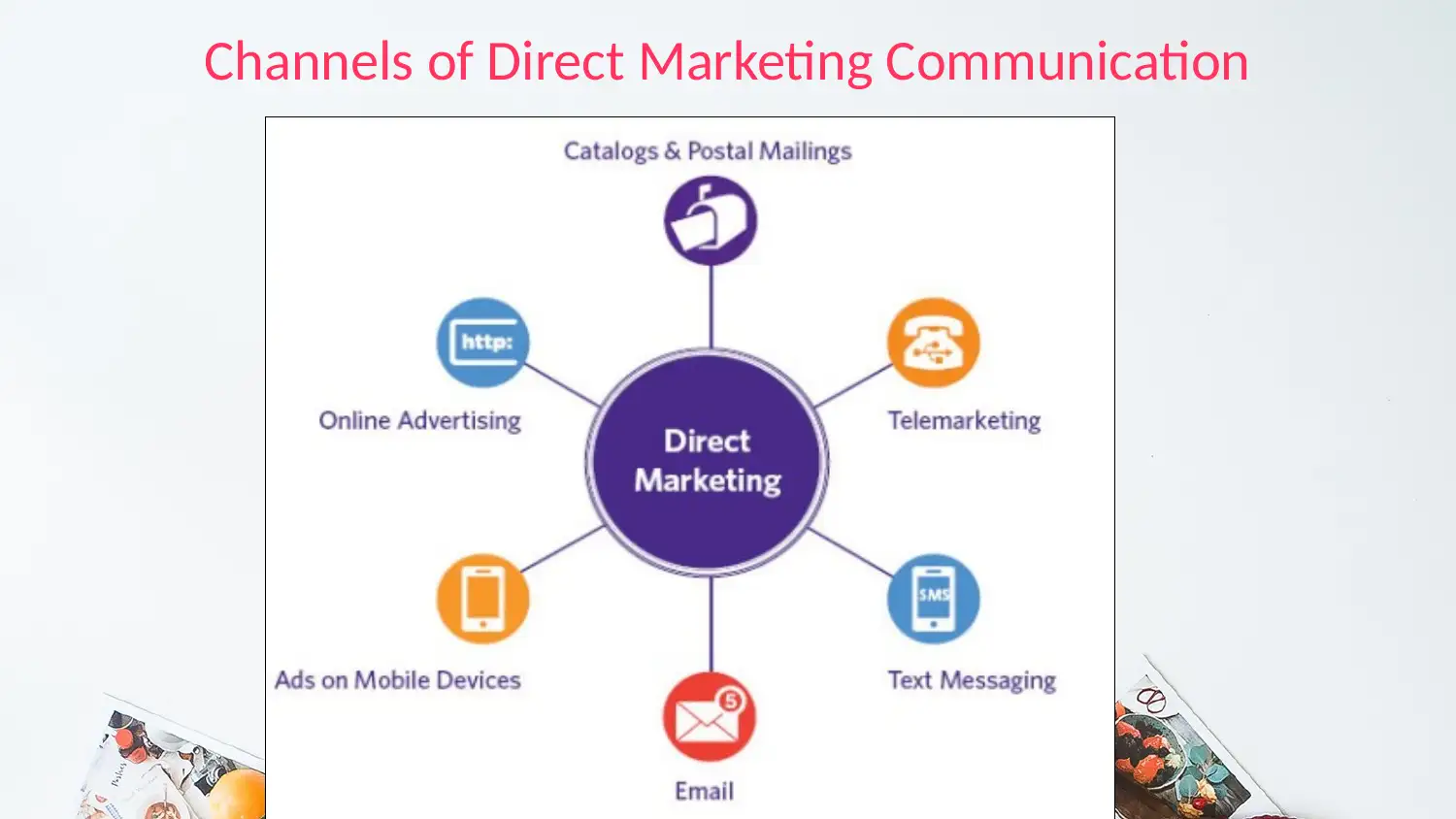
Channels of Direct Marketing Communication
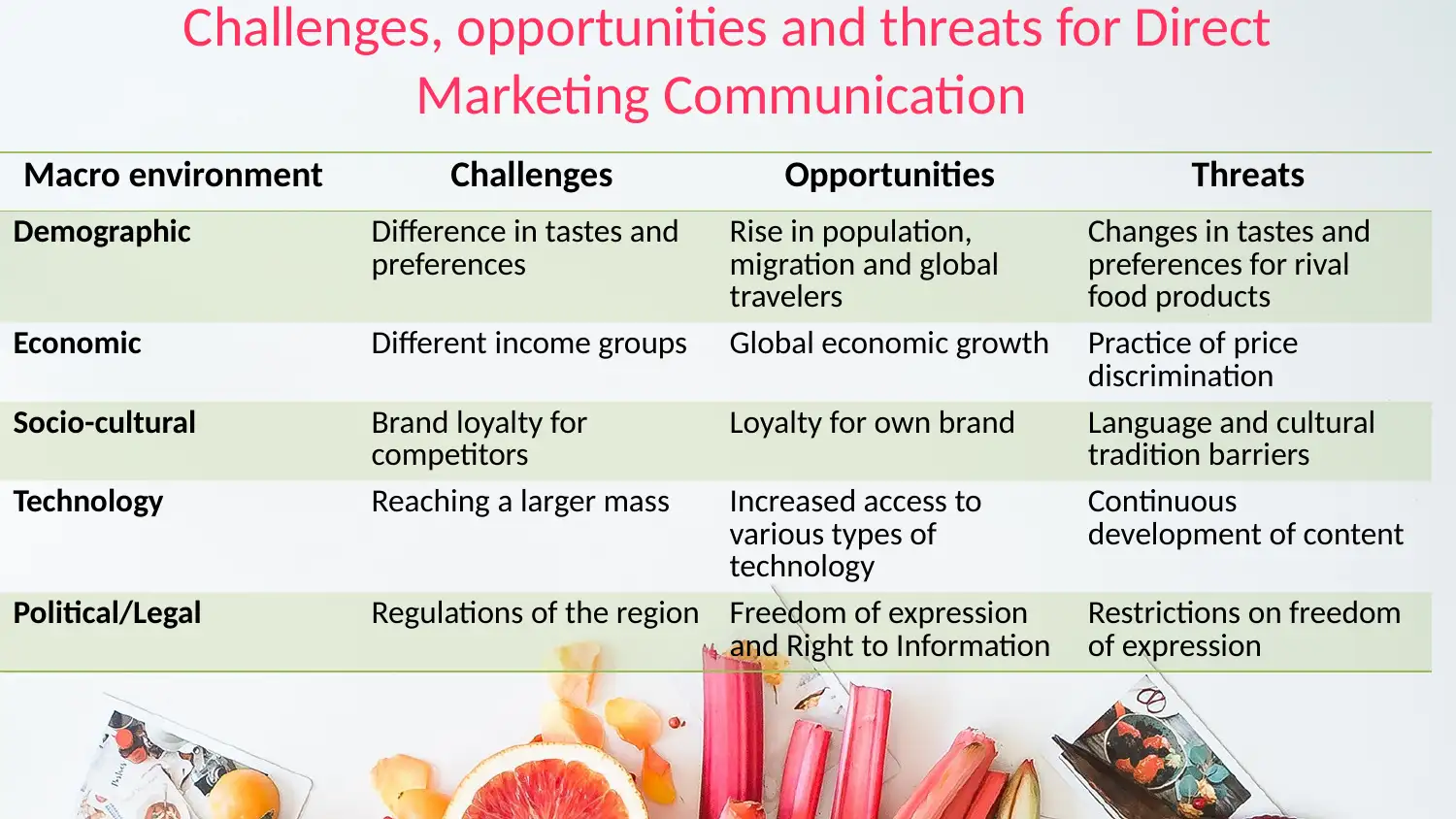
Challenges, opportunities and threats for Direct
Marketing Communication
Macro environment Challenges Opportunities Threats
Demographic Difference in tastes and
preferences
Rise in population,
migration and global
travelers
Changes in tastes and
preferences for rival
food products
Economic Different income groups Global economic growth Practice of price
discrimination
Socio-cultural Brand loyalty for
competitors Loyalty for own brand Language and cultural
tradition barriers
Technology Reaching a larger mass Increased access to
various types of
technology
Continuous
development of content
Political/Legal Regulations of the region Freedom of expression
and Right to Information
Restrictions on freedom
of expression
Marketing Communication
Macro environment Challenges Opportunities Threats
Demographic Difference in tastes and
preferences
Rise in population,
migration and global
travelers
Changes in tastes and
preferences for rival
food products
Economic Different income groups Global economic growth Practice of price
discrimination
Socio-cultural Brand loyalty for
competitors Loyalty for own brand Language and cultural
tradition barriers
Technology Reaching a larger mass Increased access to
various types of
technology
Continuous
development of content
Political/Legal Regulations of the region Freedom of expression
and Right to Information
Restrictions on freedom
of expression
⊘ This is a preview!⊘
Do you want full access?
Subscribe today to unlock all pages.

Trusted by 1+ million students worldwide
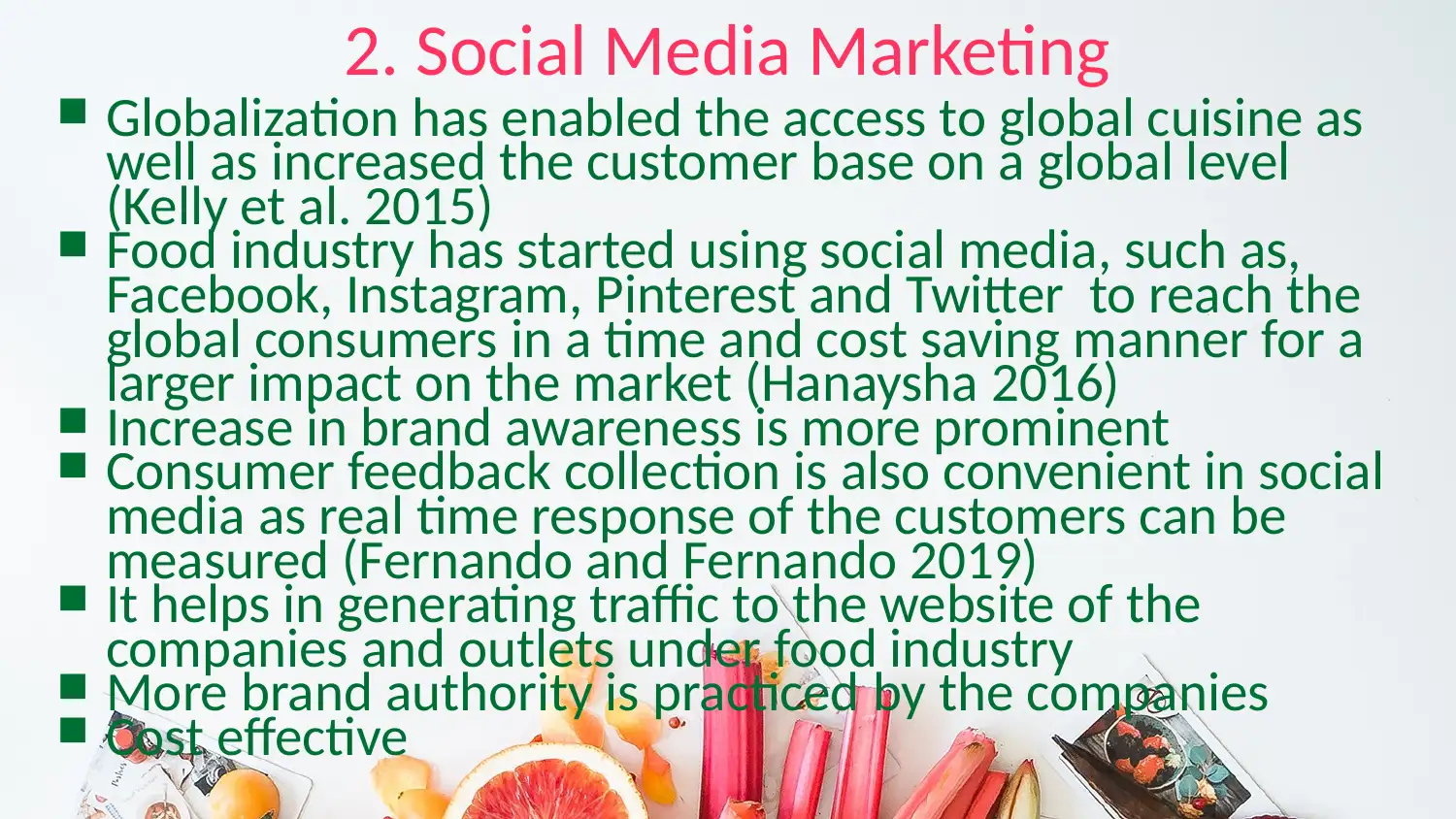
2. Social Media Marketing
Globalization has enabled the access to global cuisine as
well as increased the customer base on a global level
(Kelly et al. 2015)
Food industry has started using social media, such as,
Facebook, Instagram, Pinterest and Twitter to reach the
global consumers in a time and cost saving manner for a
larger impact on the market (Hanaysha 2016)
Increase in brand awareness is more prominent
Consumer feedback collection is also convenient in social
media as real time response of the customers can be
measured (Fernando and Fernando 2019)
It helps in generating traffic to the website of the
companies and outlets under food industry
More brand authority is practiced by the companies
Cost effective
Globalization has enabled the access to global cuisine as
well as increased the customer base on a global level
(Kelly et al. 2015)
Food industry has started using social media, such as,
Facebook, Instagram, Pinterest and Twitter to reach the
global consumers in a time and cost saving manner for a
larger impact on the market (Hanaysha 2016)
Increase in brand awareness is more prominent
Consumer feedback collection is also convenient in social
media as real time response of the customers can be
measured (Fernando and Fernando 2019)
It helps in generating traffic to the website of the
companies and outlets under food industry
More brand authority is practiced by the companies
Cost effective
Paraphrase This Document
Need a fresh take? Get an instant paraphrase of this document with our AI Paraphraser
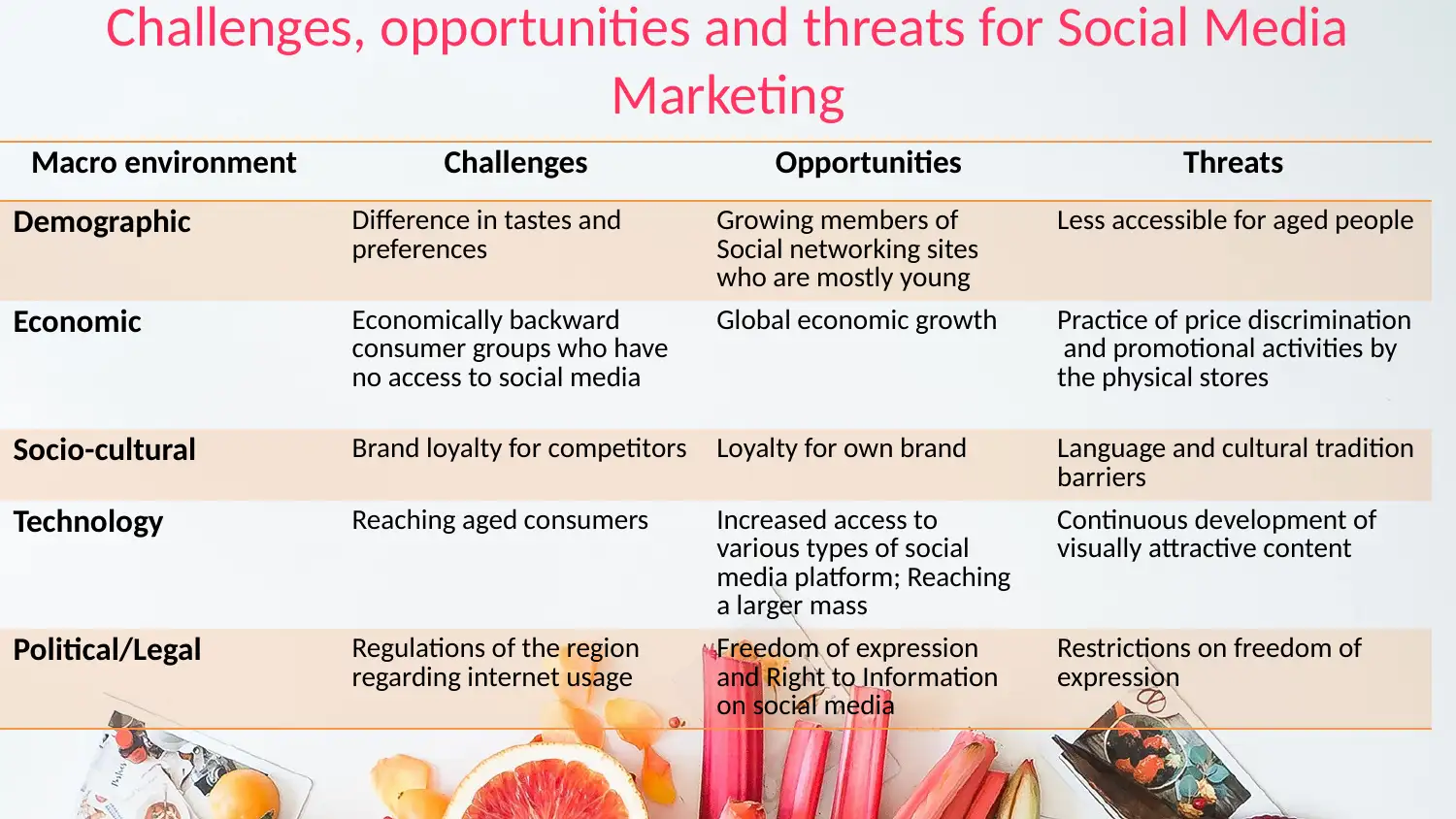
Challenges, opportunities and threats for Social Media
Marketing
Macro environment Challenges Opportunities Threats
Demographic Difference in tastes and
preferences
Growing members of
Social networking sites
who are mostly young
Less accessible for aged people
Economic Economically backward
consumer groups who have
no access to social media
Global economic growth Practice of price discrimination
and promotional activities by
the physical stores
Socio-cultural Brand loyalty for competitors Loyalty for own brand Language and cultural tradition
barriers
Technology Reaching aged consumers Increased access to
various types of social
media platform; Reaching
a larger mass
Continuous development of
visually attractive content
Political/Legal Regulations of the region
regarding internet usage
Freedom of expression
and Right to Information
on social media
Restrictions on freedom of
expression
Marketing
Macro environment Challenges Opportunities Threats
Demographic Difference in tastes and
preferences
Growing members of
Social networking sites
who are mostly young
Less accessible for aged people
Economic Economically backward
consumer groups who have
no access to social media
Global economic growth Practice of price discrimination
and promotional activities by
the physical stores
Socio-cultural Brand loyalty for competitors Loyalty for own brand Language and cultural tradition
barriers
Technology Reaching aged consumers Increased access to
various types of social
media platform; Reaching
a larger mass
Continuous development of
visually attractive content
Political/Legal Regulations of the region
regarding internet usage
Freedom of expression
and Right to Information
on social media
Restrictions on freedom of
expression
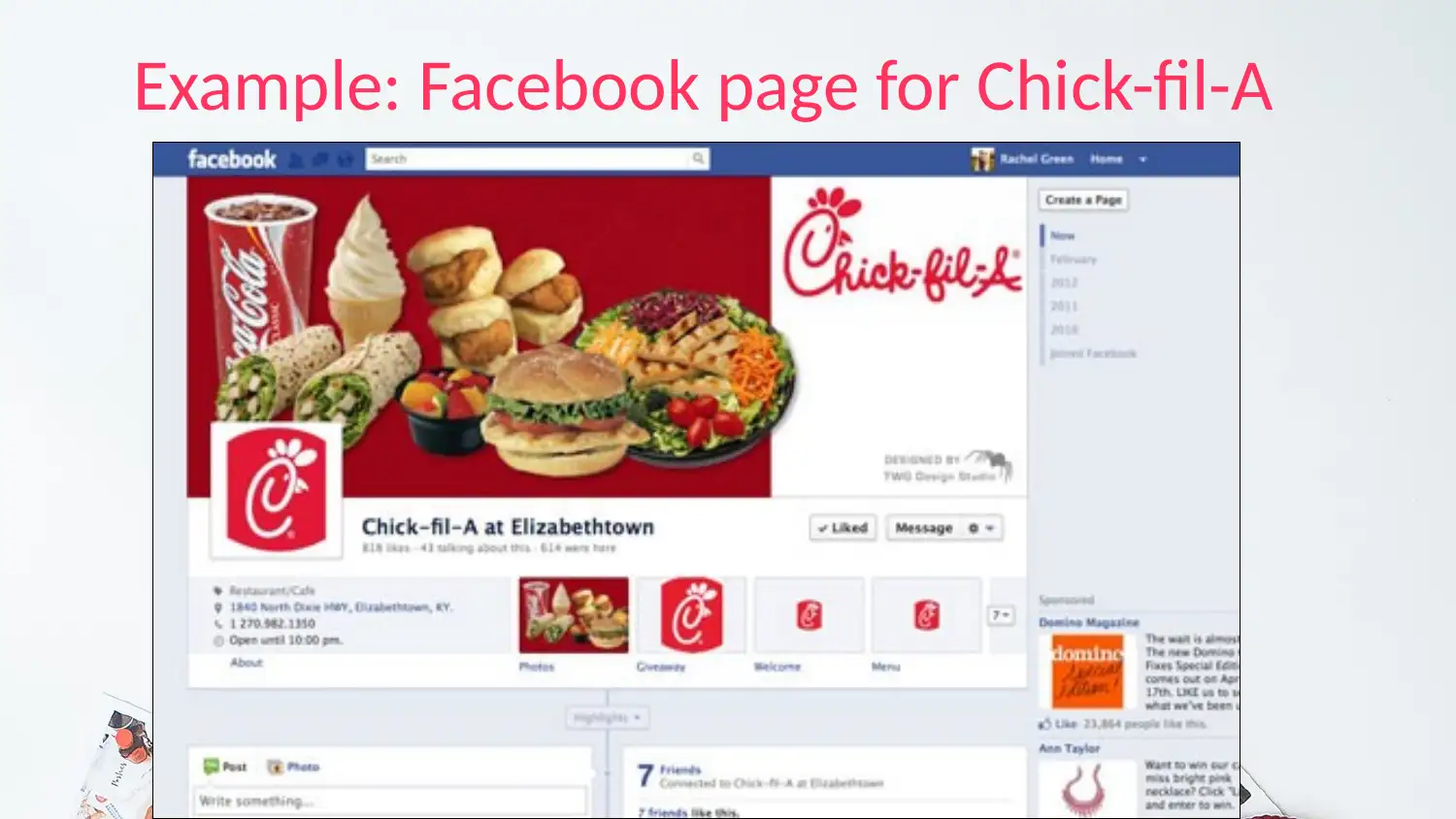
Example: Facebook page for Chick-fil-A
⊘ This is a preview!⊘
Do you want full access?
Subscribe today to unlock all pages.

Trusted by 1+ million students worldwide
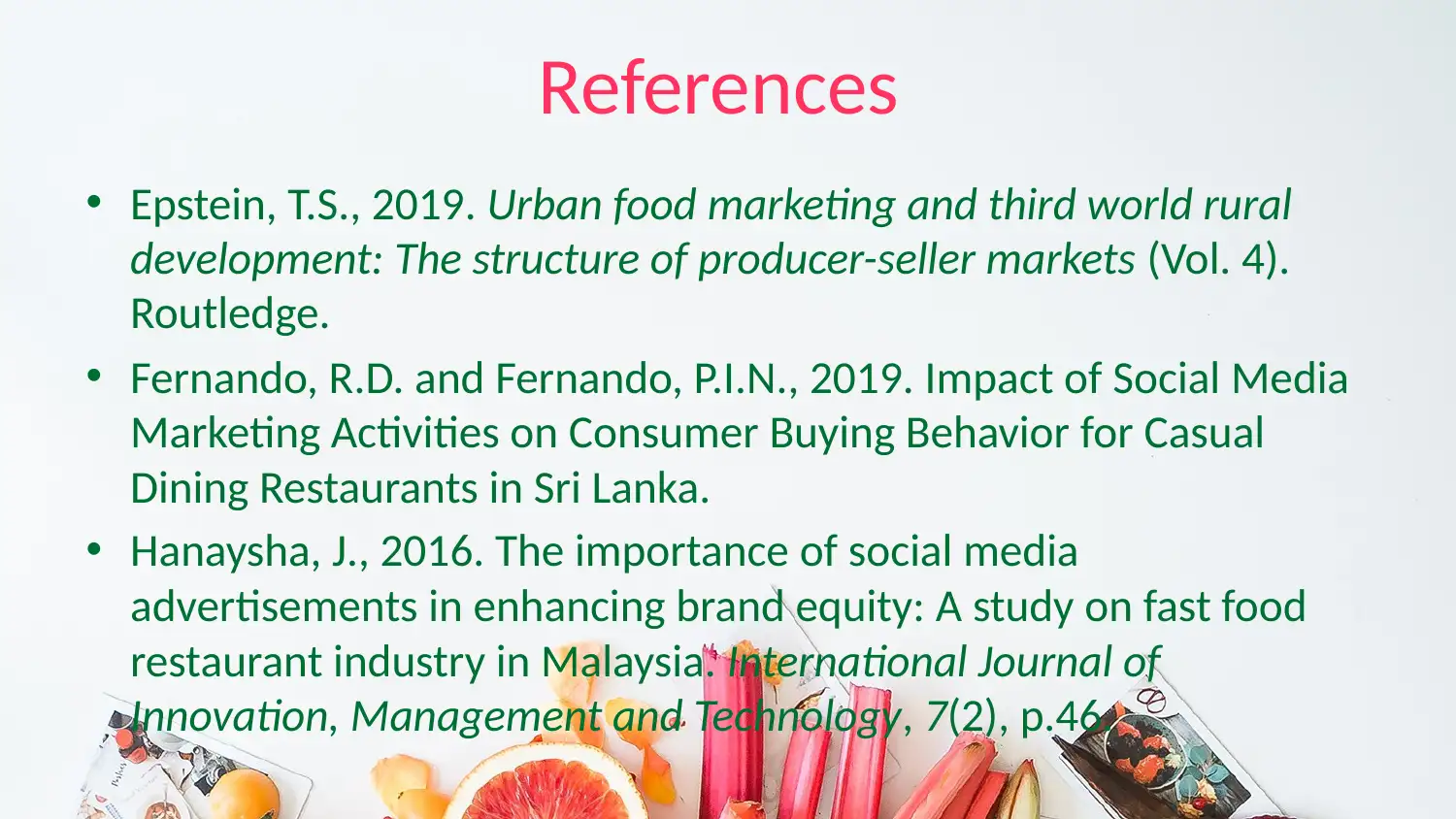
References
• Epstein, T.S., 2019. Urban food marketing and third world rural
development: The structure of producer-seller markets (Vol. 4).
Routledge.
• Fernando, R.D. and Fernando, P.I.N., 2019. Impact of Social Media
Marketing Activities on Consumer Buying Behavior for Casual
Dining Restaurants in Sri Lanka.
• Hanaysha, J., 2016. The importance of social media
advertisements in enhancing brand equity: A study on fast food
restaurant industry in Malaysia. International Journal of
Innovation, Management and Technology, 7(2), p.46.
• Epstein, T.S., 2019. Urban food marketing and third world rural
development: The structure of producer-seller markets (Vol. 4).
Routledge.
• Fernando, R.D. and Fernando, P.I.N., 2019. Impact of Social Media
Marketing Activities on Consumer Buying Behavior for Casual
Dining Restaurants in Sri Lanka.
• Hanaysha, J., 2016. The importance of social media
advertisements in enhancing brand equity: A study on fast food
restaurant industry in Malaysia. International Journal of
Innovation, Management and Technology, 7(2), p.46.
Paraphrase This Document
Need a fresh take? Get an instant paraphrase of this document with our AI Paraphraser
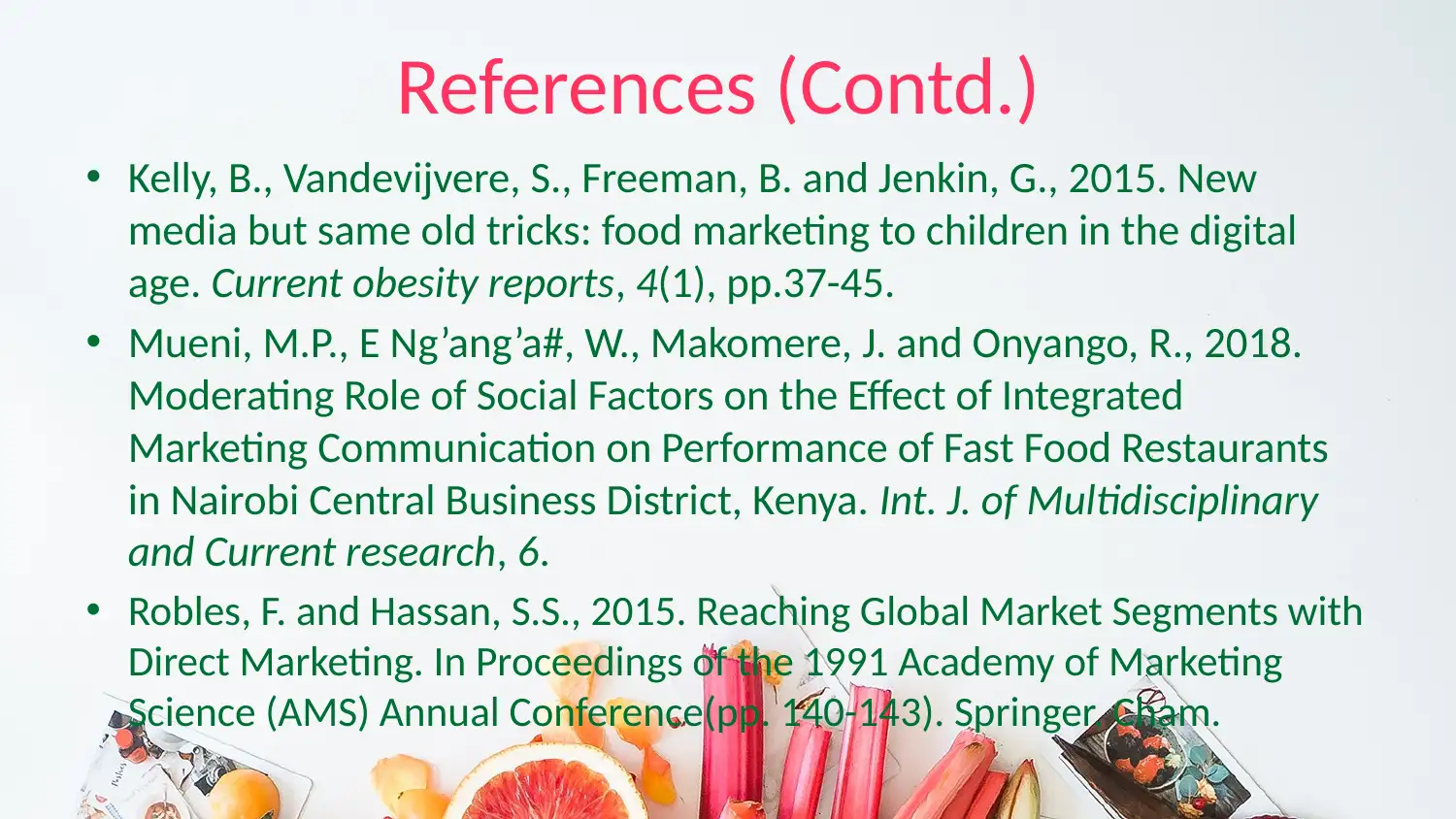
References (Contd.)
• Kelly, B., Vandevijvere, S., Freeman, B. and Jenkin, G., 2015. New
media but same old tricks: food marketing to children in the digital
age. Current obesity reports, 4(1), pp.37-45.
• Mueni, M.P., E Ng’ang’a#, W., Makomere, J. and Onyango, R., 2018.
Moderating Role of Social Factors on the Effect of Integrated
Marketing Communication on Performance of Fast Food Restaurants
in Nairobi Central Business District, Kenya. Int. J. of Multidisciplinary
and Current research, 6.
• Robles, F. and Hassan, S.S., 2015. Reaching Global Market Segments with
Direct Marketing. In Proceedings of the 1991 Academy of Marketing
Science (AMS) Annual Conference(pp. 140-143). Springer, Cham.
• Kelly, B., Vandevijvere, S., Freeman, B. and Jenkin, G., 2015. New
media but same old tricks: food marketing to children in the digital
age. Current obesity reports, 4(1), pp.37-45.
• Mueni, M.P., E Ng’ang’a#, W., Makomere, J. and Onyango, R., 2018.
Moderating Role of Social Factors on the Effect of Integrated
Marketing Communication on Performance of Fast Food Restaurants
in Nairobi Central Business District, Kenya. Int. J. of Multidisciplinary
and Current research, 6.
• Robles, F. and Hassan, S.S., 2015. Reaching Global Market Segments with
Direct Marketing. In Proceedings of the 1991 Academy of Marketing
Science (AMS) Annual Conference(pp. 140-143). Springer, Cham.

Thank You!
⊘ This is a preview!⊘
Do you want full access?
Subscribe today to unlock all pages.

Trusted by 1+ million students worldwide
1 out of 12
Related Documents
Your All-in-One AI-Powered Toolkit for Academic Success.
+13062052269
info@desklib.com
Available 24*7 on WhatsApp / Email
![[object Object]](/_next/static/media/star-bottom.7253800d.svg)
Unlock your academic potential
Copyright © 2020–2025 A2Z Services. All Rights Reserved. Developed and managed by ZUCOL.





